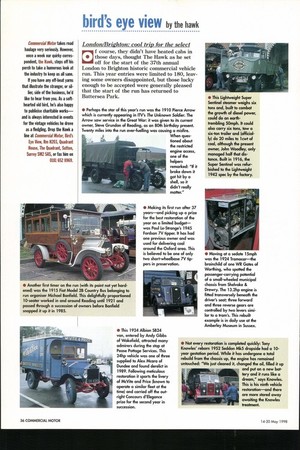bird's eye view by the hawk London/Brighton: cool trip for
Page 40

If you've noticed an error in this article please click here to report it so we can fix it.
the select f course, they didn't have heated cabs in those days, thought The Hawk as he set off for the start of the 37th annual London to Brighton historic commercial vehicle run. This year entries were limited to 180, leaving some owners disappointed, but those lucky enough to be accepted were generally pleased that the start of the run has returned to Battersea Park.
• Perhaps the star of this year's run was the 1910 Pierce Arrow which is currently appearing in ITV's The Unknown Soldier. The Arrow saw service in the Great War: it was given to its current owner, Steve Grundon of Reading, as an 80th birthday present. Twenty miles into the run over-fuelling was causing a misfire. When questioned about the restricted engine access, one of the helpers remarked: "If it broke down it got hit by a shell, so it didn't really matter." • This Lightweight Super Sentinel steamer weighs six tons and, built to combat the growth of diesel power, could do an earthtrembling 50mph. It could also carry six tons, tow a six-ton trailer and (officially) do 20 miles to lcwt of coal, although the present owner, John Woodley, only managed half that distance. Built in 1916, the Super Sentinel was refurbished to the Lightweight 1942 spec by the factory.
• Making its first run after 37 years—and picking up a prize for the best restoration of the year on a limited budget— was Paul Le-Strange's 1945 Fordson 7V tipper. It has had one previous owner and was used for delivering coal around the Oxford area. This is believed to be one of only two short-wheelbase 7V tippers in preservation.
* Another first timer on the run (with its paint not yet hardened) was the 1915 Fiat Model 2B Country Bus belonging to run organiser Michael Banfield. This delightfully proportioned 10-seater worked in and around Reading until 1921 and passed through a succession of owners before Banfield snapped it up it in 1985. • Moving at a sedate 15mph was the 1924 Tramocar—the brainchild of one WR Gates of Worthing, who spotted the passenger-carrying potential of a small-wheeled municipal chassis from Shelvoke & Drewry. The 13.2hp engine is fitted transversely beneath the driver's seat; three forward and three reverse gears are controlled by two levers similar to a tram's. This rebuilt example is in daily use at the Amberley Museum in Sussex.
• This 1924 Albion SB24 van, entered by Andy Gibbs of Wakefield, attracted many admirers during the stop at Pease Pottage Services. This 24hp vehicle was one of three supplied to Alex Mcara of Dundee and found derelict in 1989. Following meticulous restoration it sports the livery of McVite and Price (known to operate a similar fleet at the time) and carried off the outright Concours d'Elegance prize for the second year in succession. Not every restoration is completed quickly: Tony Knowles' reborn 1952 Seddon Mk5 dropside had a 10year gestation period. While it has undergone a total rebuild from the chassis up, the engine has remained untouched: "We just cleaned it, changed the oil, filled it up and put on a new battery and it runs like a dream," says Knowles. This is his ninth vehicle restoration—and there are more stored away awaiting the Knowles treatment.




































































































































